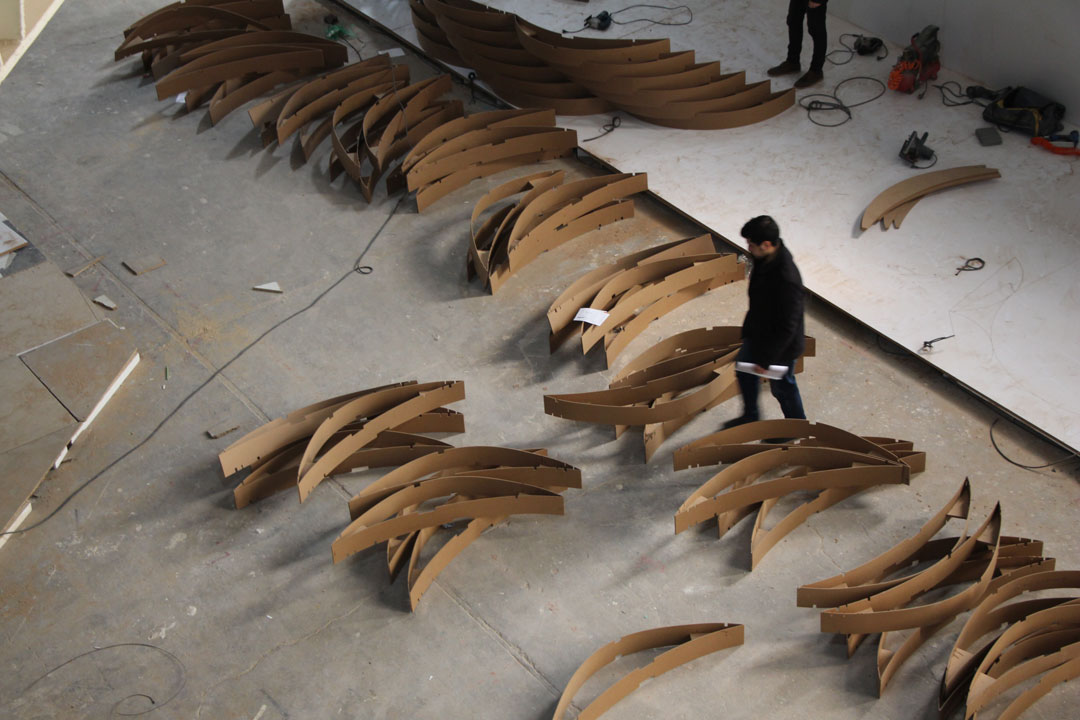company
type
role
team
marz architecture | design
space | fabrication | material study
computation designer | researcher
Farshad Nasiri, Mehrnaz Zarrin, Saleh Hariri, Mahla Behrooz, Abolhasan Karimi
2018

Methodology & Process
The methodology for this project followed a research-through-design approach, centered around material experimentation and iterative feedback. The process began with material exploration, where we examined the fundamental behaviors and limits of the chosen material through hands-on engagement. This initial phase laid the groundwork for experimental testing, which allowed us to push the material under various conditions and begin to identify patterns in its response.
All tests were carefully documented, creating a structured record of both successful and failed attempts. This documentation became a critical reference, informing the design of a base component—a core element intended to embody and exploit the material’s unique behavior.
The base component underwent multiple iterations of prototyping, with each version tested, evaluated, and refined. At key stages, the process looped back—incorporating feedback and re-testing earlier assumptions to strengthen the design outcome. This cyclical exchange between design, feedback, and testing helped maintain a dialogue between concept and material, ensuring that development was responsive and informed.
The process culminated in the design of a pavilion using the finalized base component. By scaling and repeating the component, we translated material behavior into architectural form. The result is a system that not only demonstrates the potential of the material but also reflects a deeply integrated and experimental design methodology.

MDF flexibility testing

results of MDF flexibility tests that guide us to capacity of bending



Base Component Structure
This diagram shows the structure of each unit. Each unit has two parts : wdge and skin. Cones are creating by interlocking mechanisms of units.
Geometry
This diagram shows the geometry of the cone. Each unit is different from its side unit. Each unit is unique. And it's geometry is based on an different sector of a different arc. So each unit has its own code that helps us in fabrication and creating the whole cone.





Reflections & Ongoing Thoughts
One of the most impactful aspects of this project was experiencing a truly bottom-up design process—where the work was not driven by a predetermined outcome, but instead guided by curiosity, material behavior, and open-ended exploration. This shift in approach, from result-oriented thinking to process-led discovery, was both refreshing and deeply insightful.
From the very beginning, our team had no clear vision of what the final form would be. Instead, we embraced uncertainty and allowed the material to lead the way. Every decision stemmed from physical testing, tactile feedback, and emerging patterns from our documentation. This made the design process feel more like a dialogue with the material rather than an imposition of preconceived ideas.
What has stayed with me most is the value of designing through experimentation—treating the process itself as a space for creativity, learning, and evolution. I found this approach not only more dynamic, but also more authentic. It’s a methodology I’ve grown to deeply appreciate and one I intend to carry forward into future projects. Continuing to explore how materials can shape design, rather than only serve it, has become a central line of thinking that continues to inspire my practice.